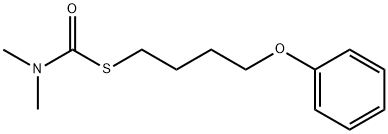
FENOTHIOCARB
- русский язык имя
- английское имяFENOTHIOCARB
- CAS №62850-32-2
- CBNumberCB5753004
- ФормулаC13H19NO2S
- мольный вес253.36
- EINECS200-589-5
- номер MDLMFCD00191225
- файл Mol62850-32-2.mol
химическое свойство
| Температура плавления | 40.5℃ |
| Температура кипения | 155 °C |
| плотность | 1.1414 (rough estimate) |
| давление пара | 1.6 x l0-5 Pa (23 °C) |
| показатель преломления | 1.6800 (estimate) |
| температура хранения | 0-6°C |
| Растворимость в воде | 30 mg l-1 (20 °C) |
| пка | -1.21±0.70(Predicted) |
| БРН | 2125738 |
| FDA UNII | R49R81TMFY |
| Коды опасности | Xn,N |
| Заявления о рисках | 22-50 |
| Заявления о безопасности | 61 |
| РИДАДР | UN 3077 9 / PGIII |
| WGK Германия | 3 |
| RTECS | FD3825000 |
| кода HS | 29309090 |
рисовальное письмо(GHS)
-
рисовальное письмо(GHS)


-
сигнальный язык
предупреждение
-
вредная бумага
H302:Вредно при проглатывании.
H400:Чрезвычайно токсично для водных организмов.
-
оператор предупредительных мер
P273:Избегать попадания в окружающую среду.
P301+P312+P330:ПРИ ПРОГЛАТЫВАНИИ: Обратиться за медицинской помощью при плохом самочувствии. Прополоскать рот.
FENOTHIOCARB химические свойства, назначение, производство
Использование
Fenothiocarb is an acaricide used to control the eggs and young stages of Panonychus citri, Panonychus ulmi and other Panonychus spp.Метаболический путь
When the red mite, applied with 14C-fenothiocarb by the contact method, metabolizes fenothiocarb, resulting in several metabolites via the primary oxidation of the N-methyl moiety. The photodegradation of fenothiocarb on silica gel plate exposed to sunlight gives rise to several degradation products. A primary photochemical reaction seems to be the oxidation of the sulfur atom to form its sulfoxide. Under greenhouse conditions, when fenothiocarb is applied to the citrus trees, the major metabolites identified in the leaves, rinds, and edible fruit are 6-O-malonyl-b-D-glucosode of N- hydroxymethyl fenothiocarb, N-formylfenothiocarb, and glucoside conjugate of phenol (not shown in the map), respectively. In soils, fenothiocarb is more rapidly degraded under upland conditions than under flooded conditions. Main degradation pathways include oxidation of the sulfur atom which results in the formation of methyl-4-phenoxybutylsulfoxide, its sulfone, and 4-phenoxybutylsulfonic acid.Деградация
Fenothiocarb has long residual activity. It is stable to hydrolysis for 5 days (pH 5-9, 40 °C) but it is decomposed slowly by sunlight (PM). [U-14C-phenyl]Fenothiocarb was applied to the origin of silica gel TLC plates and exposed to sunlight in September or October. The plates were developed, with authentic standard compounds also applied, in two dimensions using different solvent systems. After 72 hours exposure to sunlight, 34% of parent fenothiocarb remained (DT50 45 hours). Twelve photoproducts were detected. Products that were identified are illustrated in Scheme 1 and were N-formyl-fenothiocarb (2), desmethyl-fenothiocarb (3) the bis(4-phenoxybutyl) thiolsulfinate (4), the bis(4-phenoxybutyl) thiolsulfonate (5), the sulfoxide derivative (6) and 4-phenoxybutanesulfonic acid (7). The latter two compounds were major products. The primary photochemical reaction was oxidation of sulfur to form fenothiocarb sulfoxide (6) followed by cleavage of the ester linkage and the oxidation or dimerisation of the 4-phenoxybutanesulfenic acid intermediate. The second main route of photodegradation was oxidation of the N-methyl moiety of fenothiocarb (Unai and Tomiwaza, 1986b).FENOTHIOCARB запасные части и сырье
FENOTHIOCARB поставщик
| поставщик | телефон | страна | номенклатура продукции | благоприятные условия |
|---|---|---|---|---|
| 18871490254 | CHINA | 28172 | 58 | |
| +86-023-6139-8061 +86-86-13650506873 |
China | 39894 | 58 | |
| +86-0371-86658258 +8613203830695 |
China | 29809 | 58 | |
| +86-29-87569266 15319487004 |
China | 3939 | 58 | |
| +1-781-999-5354 +1-00000000000 |
United States | 32161 | 58 | |
| +86-0512-83500002 +8615195660023 |
China | 23046 | 58 | |
| +86-852-30606658 | China | 43340 | 58 | |
| 010-82848833 400-666-7788 |
China | 96815 | 76 | |
| 400-1166-196 18981987031 |
China | 11707 | 57 | |
| +86057186818502 13588463833 |
China | 10266 | 58 |